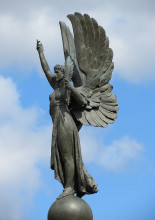
The New Barnet War Memorial at the junction of Station Road and East Barnet Road in North London consists of a tall stone obelisk, with a bronze statue of an Angel of Peace on the top, on a globe. On the lower front of the obelisk is a lion carved in the stone, with beneath it the inscription, and then the names of those who fought and died in World War 1 on panels around the square base. The statue of the angel is shown walking rather than alighting on the globe. She faces forward, one arm raised aloft, her hand with fingers splayed as if grasping at some higher plane; her other hand holds a feather. She is semidraped, with a light shift around her body and handing down to her feet, emphasising the roundness of her thighs and lower legs. Her upturned face is Classical, rather hard in the contours, her hair is short, and she wears a wreath of leaves upon her brow, Her physique, in Classical fashion, is muscular, with solid chest, shoulders and biceps, and above all the powerful neck, all this being somewhat counter-balanced by the feminine curvaceousness of her legs, which are rather emphasised by the drapery. Overall, then, we have a creature of her times, having something of the Edwardian Classical, somewhat more of a tendency to the Art Deco.
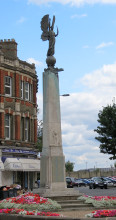 New Barnet War Memorial, showing column.
New Barnet War Memorial, showing column.
The sculptor of this work was Newbury Trent, who made his name with World War I memorials, and then turned to other things, and was also a medallist. The statue thus reflects the intermediate period both of its time, at the beginning of the 1920s (it was unveiled in 1921), and of the sculptorís career, which spanned from Edwardian times through Art Deco, and on to the early 1950s, for he continued to produce sculpture almost up to his death in 1953.
Views of Newbury Trent's figure of Peace.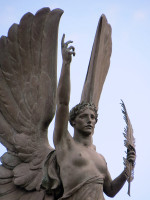
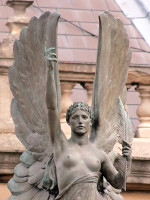
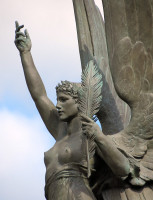
Trent made two or three rather similar works to this one. The pictures below show the similarity of his figure in Brighton for the Edward VII Memorial to the Barnet war memorial. The pose, wings and head are very similar, but the raised arm of the Brighton figure holds an olive branch, and her other hand cradles an orb with a crucifix on top. Though still semi-clad, her drapery is rather heavier, the emphasis being on the vertical folds, and she wears a cloak which hangs over her arms, which are left bare in the Barnet example. More on the Brighton piece on this page.
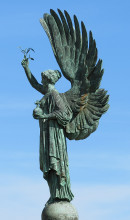
 Brighton's Edward VII memorial and the Barnet War Memorial figures compared.
Brighton's Edward VII memorial and the Barnet War Memorial figures compared.
Allegorical figures of angels on globes are fairly widespread, the type being popular from late Victorian times, and the best known example being the Peace figure by Thomas Brock on the Victoria Memorial. Newbury Trentís figure bears some resemblance to the Victoria Memorial one, in the wide hips, lightness of the drapes gathered below the breasts, and the raised hand, though the Victoria one is more of a beckoning gesture. A rather different example would be Albert Toftís angel of Peace for the Welsh National Memorial, which is more art nouveau in style.
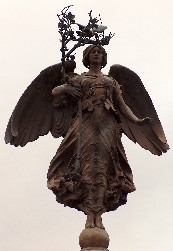 Albert Toft's figure of Peace, Welsh National Memorial, Cardiff.
Albert Toft's figure of Peace, Welsh National Memorial, Cardiff.
The lion at the base of the Barnet Memorial is also the work of Newbury Trent, but time and pollution have rather damaged the soft stone, and cleaning, though necessary to avoid further decay, has left the panel a bit too white so that the contrast is not so great. The lion is sitting upright, under his claws a stylised flat body of an eagle, representing the triumph over the Germanic peoples in the War; behind is the rising sun of a hopeful dawn. There is a page on lion statues here.
This page was originally part of a 'sculpture of the month' series, for Nov 2013. Although the older pages in that series have been absorbed within the site, if you would wish to follow the original monthly series, then jump to the next month (Dec 2013) or the previous month (Oct 2013). To continue, go to the bottom of each page where a paragraph like this one allows you to continue to follow the monthly links.
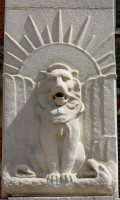 New Barnet War Memorial lion, also by Newbury Trent.
New Barnet War Memorial lion, also by Newbury Trent.
Nearby High Barnet Church monuments
Visits to this page from 1 Nov 2013: 7,846